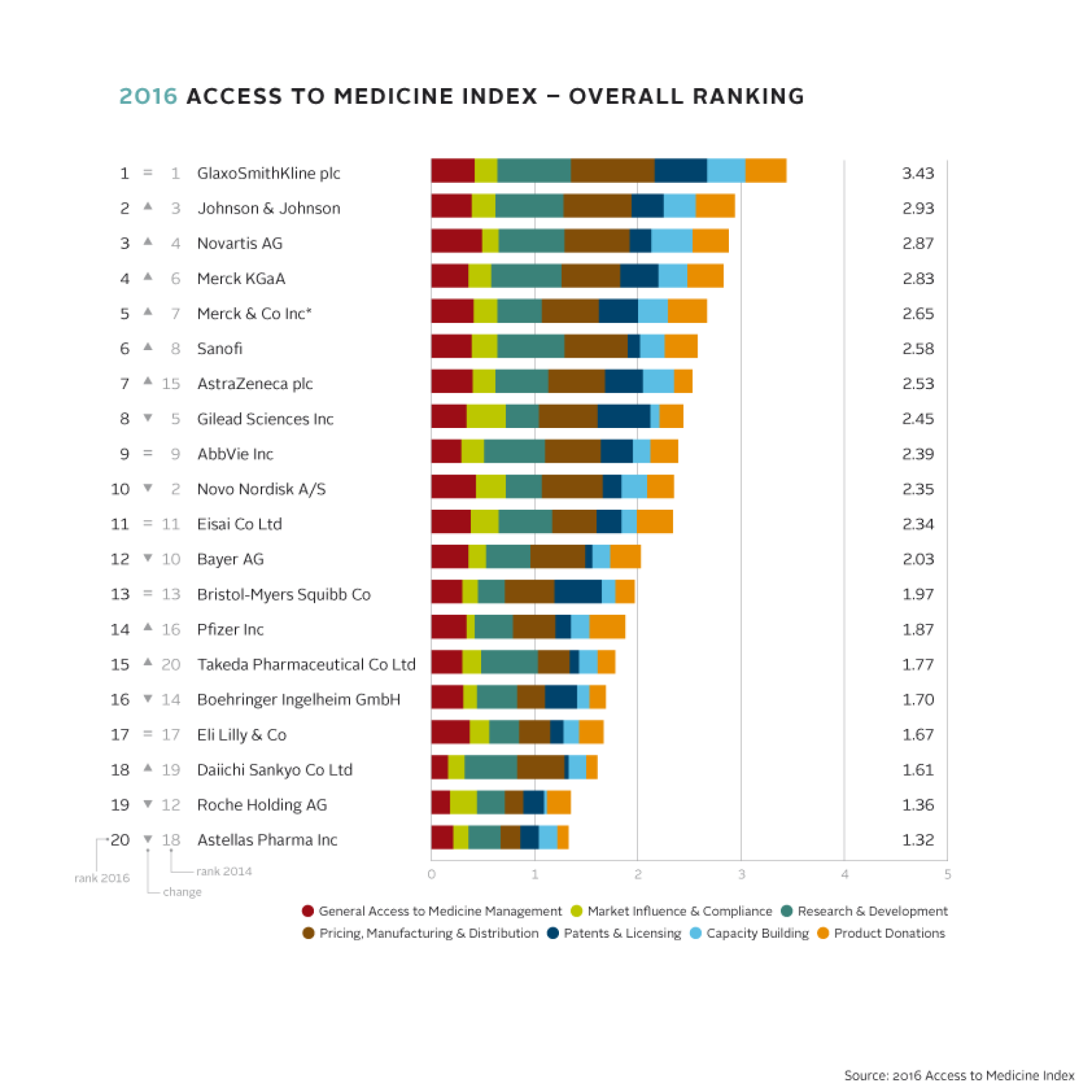Strategie van farmaceutische bedrijven om de armen te bereiken wordt volwassener. Maar de uitbreiding gaat stapsgewijs
The Access to Medicine Index, published today, ranks the top 20 pharmaceutical companies according to their efforts to improve access to medicines in 106 low- and middle-income countries. In the fifth edition of the Index GSK again leads the ranking. This company performs best when it comes to developing medicines that are specifically needed in poor countries, making medicines affordable and large-scale donation programs for forgotten tropical diseases.
GSK is closely followed by three companies that also score well: Johnson & Johnson, Novartis and Merck KGaA. The pharmaceutical industry is very diverse, and the approach companies choose for access-to-medicine ditto. However, the four companies at the top of the Index do share a number of characteristics. For example, they have the most mature access programs, which are linked to a business strategy to operate sustainably in emerging markets. They invest in R & D for medicines and vaccines, where there is an urgent need for developing countries.

This year the Index measured more closely the extent to which the access programs of pharmaceutical companies focus on diseases, countries and population groups where the priority is highest for new and affordable medicines. Here the Index shows varying results.
The companies have 850 products on the market for the 51 most burdensome diseases in low- and middle-income countries, and there are another 420 products under development. This includes 100 products that have been newly introduced since 2014, and 151 products that are commercially less interesting for the pharmaceutical industry but which are urgently needed.
The Index shows that companies do the majority (67%) of their research projects for products with high priority but with little commercial potential in collaboration with partners.
Jayasree K. Iyer, Director of the Access to Medicine Foundation: "We clearly see that the industry embraces collaborative models when it comes to the development of medicines that are urgently needed and that would otherwise not be eligible, because there is no commercial market for them. . This is a positive development. "
Progress in making more medicines more accessible is also evident in the way companies deal with their patents and the extent to which they allow other producers to make generic versions of their products. Since 2014, seven companies have made new or extensive commitments that they will abandon their patent rights for certain products in certain regions. There are now more HIV / AIDS products that are covered by voluntary licenses and they apply in more countries than ever. And for the first time, they are also being used to expand access to medicines for a disease other than HIV / AIDS, namely hepatitis C. Worldwide, between 130 and 150 million people suffer from chronic hepatitis C infection.
However, a medicine can only be made available in a country if it is registered there. The Index shows that companies only register their latest products in a quarter of the countries with the highest urgency.
The affordability of medicines, vaccines and diagnostic tools is another important component of access. According to the Index, price strategies focused on the purchasing power of poorer people in one third of the products (280 of the 850 products) for the diseases measured by the Index are applied. But only
5% of these products (44 out of 850) have a pricing strategy that meets the criteria of the Index, taking into account a range of socio-economic factors. The majority of these products are from GSK, AstraZeneca and Sanofi.
Other findings:
A quarter of the companies surveyed (5) are working on pilots for new business models that aim to reach low-income countries.
Diseases that receive the most attention from companies in the context of access to medicines are: cardiovascular diseases, infections of the lower respiratory tract and HIV / AIDS.
R & D focuses on five diseases, with an emphasis on infections of the lower respiratory tract, followed by diabetes, malaria, viral hepatitis and HIV / AIDS.
Most companies are working to improve health systems in low and middle-income countries. Six companies gear their activities to what is needed in a country, and together with governments, universities and NGOs.
The biggest risers of the Index are AstraZeneca and Japanese Takeda. These two companies have considerably expanded and renewed their access to medicines strategy. AstraZeneca has risen eight places and is now in the top 10 on spot 7. Takeda climbed five places to place 15.
Novo Nordisk, Roche and Gilead have in the meantime been overtaken by the competition and were the strongest bearers of the Index.
Iyer: "We have now followed these 20 companies for ten years. We know what works, and where. Good work is being done and where there are mechanisms that stimulate the pharmaceutical industry, such as collaborative models for R & D and joint international efforts for certain diseases, we see that industry responds to this. Access to medicines is a responsibility of all parties. Industry, governments, NGOs and the international community must challenge themselves to go a step further. We want more products in more countries, so that medicines and vaccines end up with the people who need them. "
- END OF PRESS RELEASE -
Notes for Reporters / the Press
The Access to Medicine Index is a non-profit organization based in the Netherlands. developed countries. The Index methodology was developed, and is continually refined, in consultation with multiple expert stakeholders including the World Health Organization, NGOs, governments and universities, as well as institutional investors. The Index is funded by the Bill & Melinda Gates Foundation, the Dutch Ministry of Foreign Affairs and the UK Department for International Development.